Cacti generally have thick herbaceous or woody chlorophyll-containing stems. The majority of cacti in the absence of leaves have spines, needles, or short hairs protruding out of areoles on the stem. Most spines are straight or have a slight curve or hook but can also be flattened in appearance.
The cactus family includes a large variety of succulent plants that vary size and color. Some grow into tall columns, reaching up to 50 feet high, while others are only a few inches high and well-suited for growing in pots. Here are some of the Popular Cactus Varieties With Purple Color.
- Purple Prickly Pear (Opuntia macrocentra)
- Santa Rita Prickly Pear (Opuntia violacea)
- Beaver Tail Prickly Pear (Opuntia basilaris)
- Strawberry hedgehog (Echinocereus engelmannii)
- Catclaws (Ancistrocactus uncinatus)
- Old Man Opuntia (Austrocylindropuntia vestita)
- Old Lady Cactus (Mammillaria hahniana)
- Poliedric Cactus (Mammillaria polyedra)
Purple prickly pear
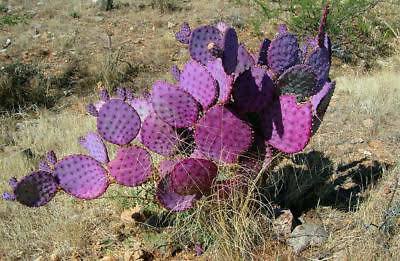
The purple prickly pear grows in clumps, usually to about 4 feet tall by 5 feet wide. This cactus appears much like a shrub. The large leaf pads develop a purple tinge in the cool, dry winter months. The pads are covered with large, tan spines.
Flowers appear in late spring, and are yellow with red centers. The rich purple pads provide plenty of interest. During the summer, the pads are a softer blue-grey color. Bright yellow flowers, to 3 inches in diameter, produce red to purple fruit. Like all cacti growing in a temperate climate, it’s best grown as a houseplant but containers may be moved to a sunny, sheltered patio in midsummer.
Santa Rita Prickly Pear
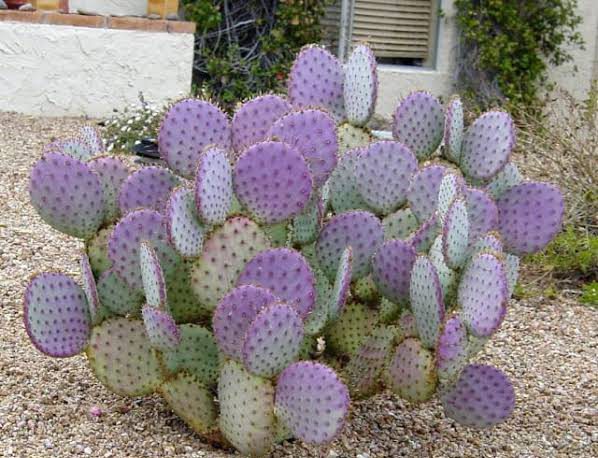
This low-growing prickly pear cactus forms large clumps and has a short trunk growing to heights of two to five feet with an equal spread. It produces flat, round, reddish-purple pads that grow to eight inches. The color of the pads intensifies when the plant is stressed by cold weather or drought conditions.
During the summer months, the pads are a softer bluish-gray color. The pads will not always develop spines but spines may be present along its perimeters and areoles. Its flowers are orange-red in color and appear in late spring. After flowering, the plant develops an oblong, purple, plump fruit.
Beavertail Cactus
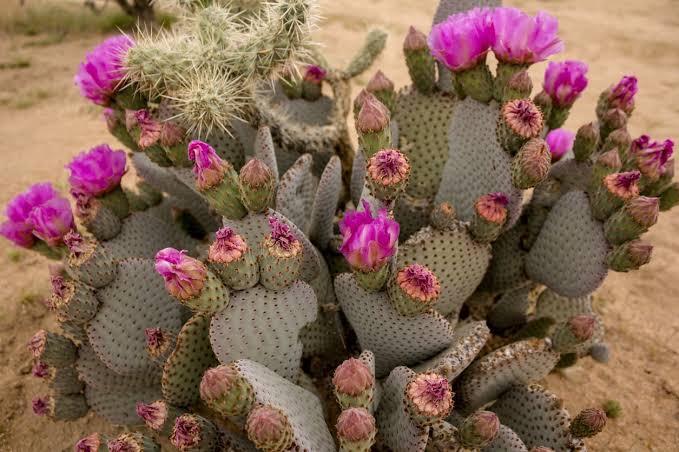
Beavertail Cactus is a bushy succulent shrub with gray-blue, wide and flat, fleshy pads resembling beaver tails. During arid conditions, the pads take on an attractive purple tinge. Lacking the long spines of other prickly pears, the pads are covered with tiny, gray-blue bristles with barbed tips.
Sitting on the top edges of the pads, brilliant rose-purple flowers, 2-4 inches wide open from spring to early summer. They are followed by small, spineless, brownish-gray fruits that are attractive to birds. This plant forms low clumps and does not develop a woody central trunk. Like all cacti growing in a temperate climate, it’s best grown as a houseplant but containers may be moved to a sunny, sheltered patio in midsummer.
Strawberry Hedgehog Cactus

Strawberry Hedgehog Cactus is a small clumping cactus forming large colonies of as many as 100 or more stems at maturity. The stems are composed of 10 to 12 ribs with fairly deep furrows between them. Very large and beautiful, bright pink to purple-red flowers decorate the plant in summer. They give way to edible, strawberry-tasting fruits, that are devoured by wildlife.
Strawberry Hedgehog Cactus is a lovely plant for a rock garden or containers where it will form attractive, bold clumps. In pot culture, this species requires well aerated gritty substrate and a hot and sunny location in the summer. During winter, this species tolerates light frost and wet (if well-drained) soil. In cultivation, this species usually does not bloom until it develops 2-3 branches.
Catclaws
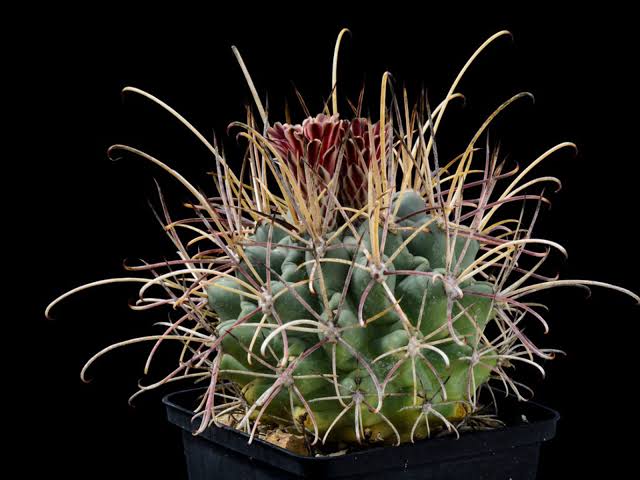
When mature the plant is only about 6 inches (15 cm.) tall and may be round or slightly elongated. It has no stems but is covered in the long red, hooked main spines and peripheral spines of beige that are much shorter.
The skin of the plant is bluish green and bumpy with large tubercles. In spring, mature cacti produce funnel shaped flowers in a rusty red to maroon. Each 3-inch bloom (7.6 cm.) develops into a thick, red fruit. It is a lovely plant for a rock garden or containers where it will form attractive, bold clumps.
Old man cactus

Old man cactus usually attains 6 metres (about 20 feet) before flowering and can grow to twice that height. The flat-faced flowers are produced from a mass of long wool and bristles that cap the stem.
Younger plants are almost completely covered by the white hairs, while older plants tend to be covered near the growing tips of the stems. Sharp spines are borne beneath the woolly hairs. Flowers are night-blooming and are typically purple or pink outside and white within.
Old Lady Cactus
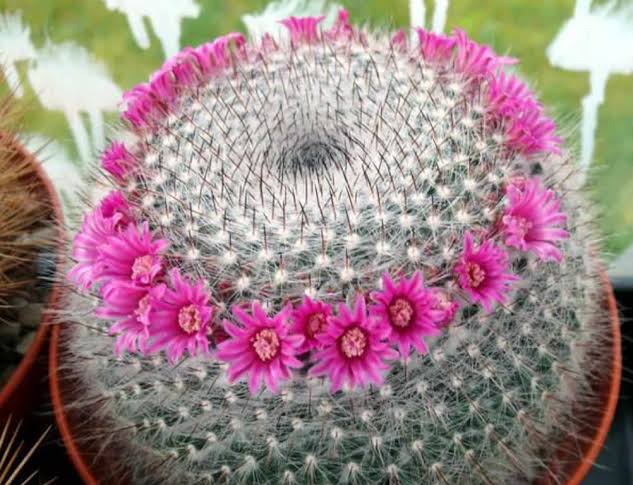
Mammillaria hahniana, also known by its common name ‘Old Lady Cactus’, is a popular powder puff type cactus. It is also known as the Old Lady Pincushion, or the Birthday Cake Cactus. The Old Lady cactus loves the outdoors, but it can also be successfully grown indoors, in most homes and offices.
Old Lady Cactus produces single stems or clusters, they are light green and covered in white bristly hairs and fine white spines. The globular offsets grow about 20cm in height and spread. This cactus will produce attractive purple-red flowers measuring around 1cm long, in the spring and autumn, small red berry fruit are produced in the summer.
Poliedric cactus
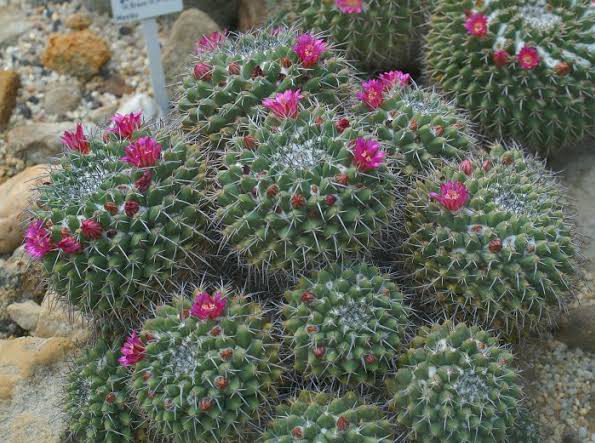
Poliedric cactus is a low growing cactus, solitary at first, later branching to form colonies or cushions. It can only be identified when in flowers, because in its vegetative state it is difficult to separate from other species in the polyedra group. The flowers are generally pink or purple in color. Depending on their size, you can find these cacti in independent containers, or in terrariums, combined with other succulents.